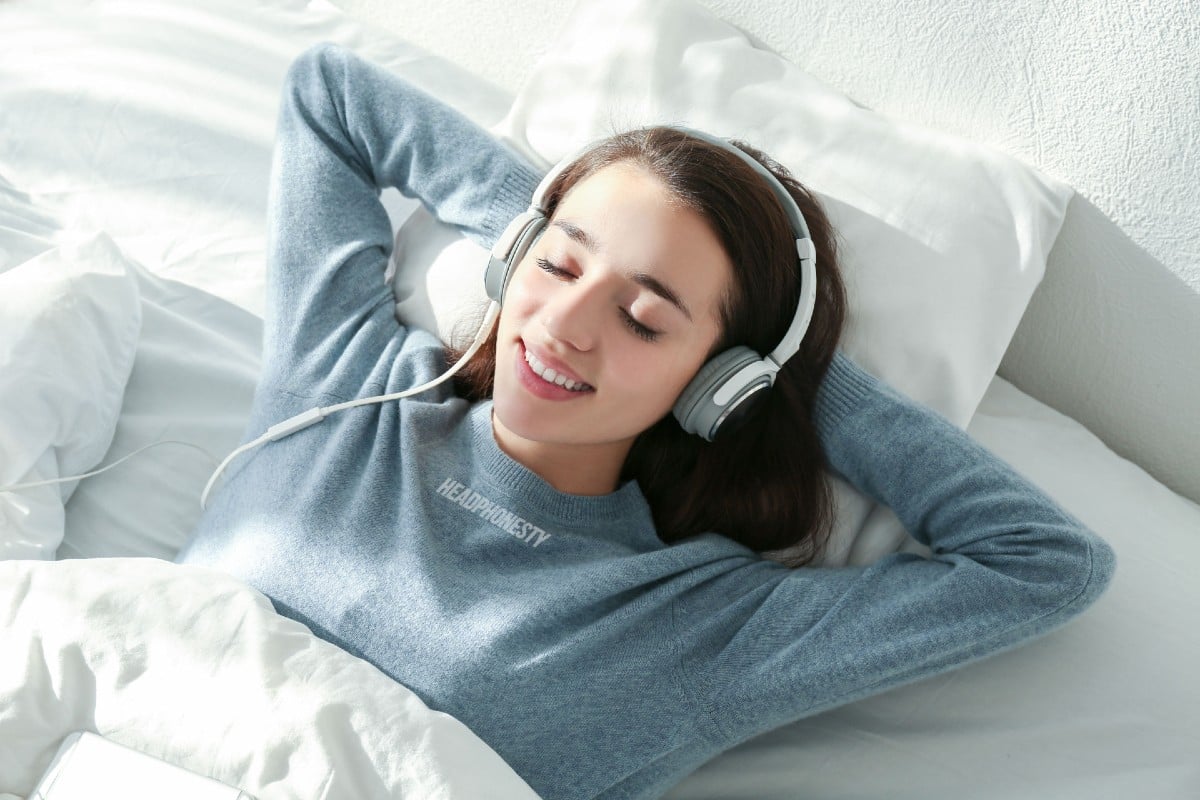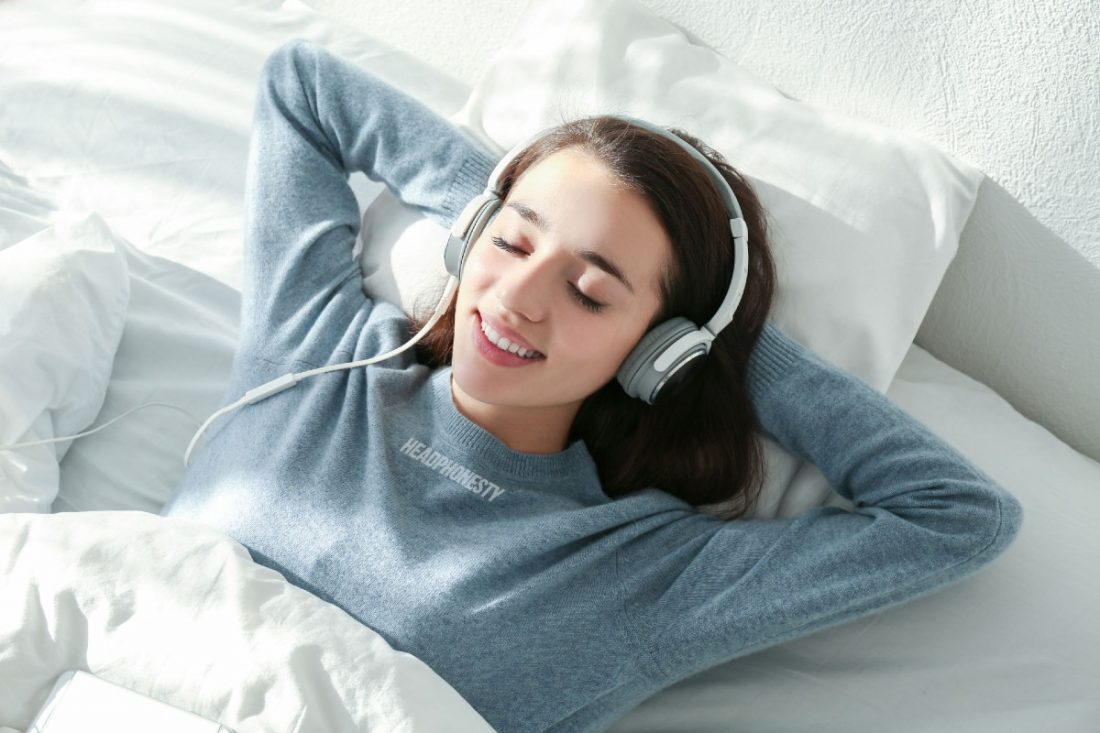Everything you need to know if you want to sleep while listening to music with your headphones on.
Sleep is one of the few things that grows more precious to us as we become older. Yet deep, satisfying sleep often gets harder to come by as we age.
Sleeping with headphones on is one of the best remedies for this modern-day predicament. It’s a great way to lull yourself to sleep without interrupting others who might be sharing the same bed or room with you.
The only problem is most headphones are bulky and not designed to be slept in. You may find that, after a few hours, you’re tearing the headphones off your head because your ears feel boxed in. Or you’re suffering from a stiff neck the next morning because you can’t sleep on your side.
Don’t worry.
There are many ways to wear your headphones in bed without having to wake up feeling like you used a rock for a pillow last night.
Keep reading if you want to know how to sleep with headphones comfortably.
- Why Would You Want to Sleep with Headphones?
- How to Sleep with Headphones – the Easiest Ways
- What Are the Advantages of Sleeping with Headphones On?
- What Are the Disadvantages of Sleeping with Headphones On?
- Is It Bad to Sleep With Noise-Canceling Headphones?
- Can Noise-Canceling Headphones Block Snoring?
- What are the alternatives to sleeping with headphones on?
- Conclusion
- Why Would You Want to Sleep with Headphones?
- How to Sleep with Headphones – the Easiest Ways
- What Are the Advantages of Sleeping with Headphones On?
- What Are the Disadvantages of Sleeping with Headphones On?
- Is It Bad to Sleep With Noise-Canceling Headphones?
- Can Noise-Canceling Headphones Block Snoring?
- What are the alternatives to sleeping with headphones on?
- Conclusion
Why Would You Want to Sleep with Headphones?
Can you sleep with headphones on? Yes, it’s totally possible to enjoy a good night’s sleep while wearing headphones.
In fact, going to sleep while listening to music you like offers a lot of benefits for your well-being, such as:
- Relaxation – Numerous studies show that listening to the right kind of music induces the relaxation response in your body. It slows down your heart rate and breathing, allowing you to let go of the stresses of the day and fall into a deep sleep quickly. It can even help patients with insomnia and post-traumatic stress disorder (PTSD).
- Happy brain chemicals – Listening to music releases dopamine, a neurotransmitter associated with feeling good. When you eat good food or hit a goal, your brain releases dopamine. When you listen to anything you like, including music, a podcast, a movie, or even an ASMR video, your brain also releases dopamine. This natural chemical helps you feel good so you can go to sleep more easily.
- Distraction-free nighttime environment – Sleeping with earbuds or headphones blocks out loud and excessive sounds that can keep you up all night long. A good pair should be able to cut out the sounds of traffic if you’re a city-dweller, noisy neighbors who party all night, or your partner snoring like a sailor next to you.
How to Sleep with Headphones – the Easiest Ways
If you want to sleep with headphones on, there are a few things you can do to make sleep time more comfortable.
Get a pillow that makes headphone listening easy
Anyone who’s tried sleeping with headphones on for a full eight hours knows it can get painful.
Almost all pillows weren’t designed for devices as cumbersome as headphones. They can press against the earcups, which, in turn, press against your ears and cause discomfort.
Also, the extra pressure on the headphones can cause damage to the electronics.
Luckily, there are some special pillows that can make listening and sleeping far more enjoyable.
The Original Pillow With a Hole
This pillow was originally made for people who need to relieve ear pain after ear surgery or are suffering from ear discomfort.
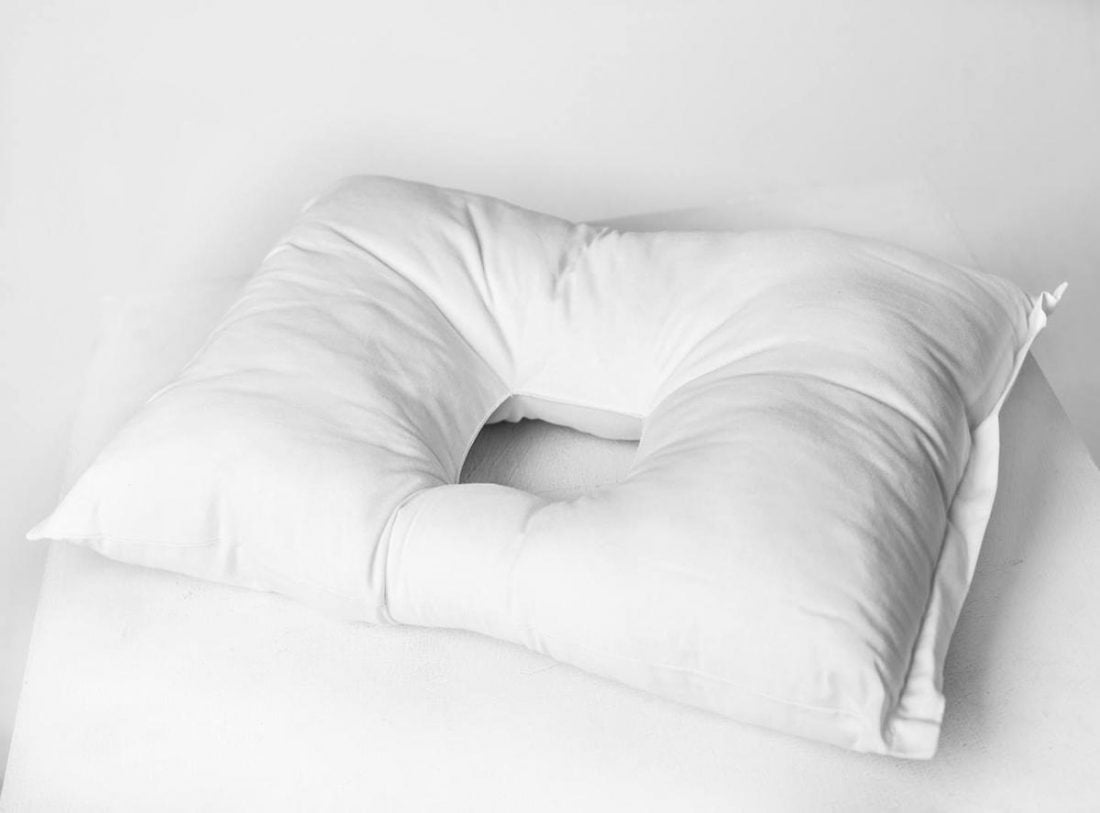
As you can tell by its name, The Original Pillow With a Hole has a 4-inch x 4-inch hole in the middle to provide just the right amount of space for one of the earcups to go through.
It’s a great pillow for side sleepers because it relieves pressure from the earcup that’s pressing against the pillow.
There’s also a zip that lets you add or remove stuffing to make it softer or firmer according to your liking.
Travel Pillow
Travel pillows are the best friends of people on the go.
It can be used to relieve pressure on the headphones in two ways. One is when you’re sleeping upright or sitting down, and second is when you sleep on your side.
When you’re sleeping during a flight or a road trip, you obviously lose control of your neck. This causes your head to sway in all directions and the weight of the headphones even adds more momentum.
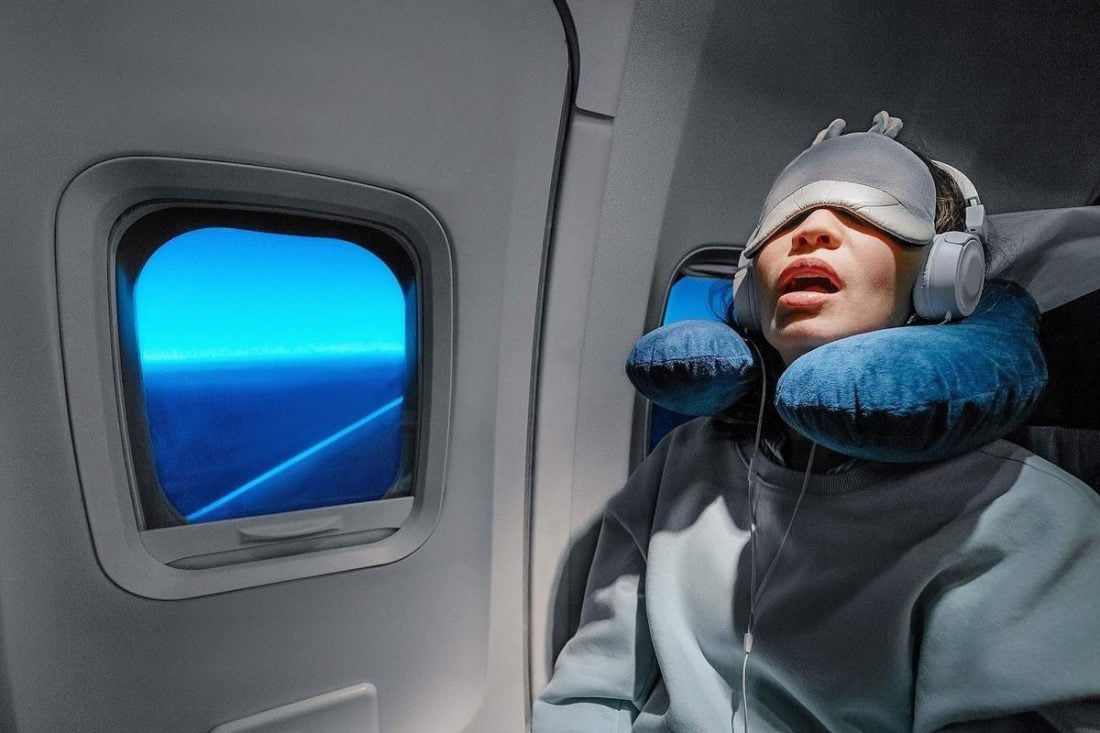
Travel pillows snuggly fit around your neck to give your chin and jawline an area to fall and rest on. It will not come in contact with your headphones so pressure while sleeping won’t be a problem.
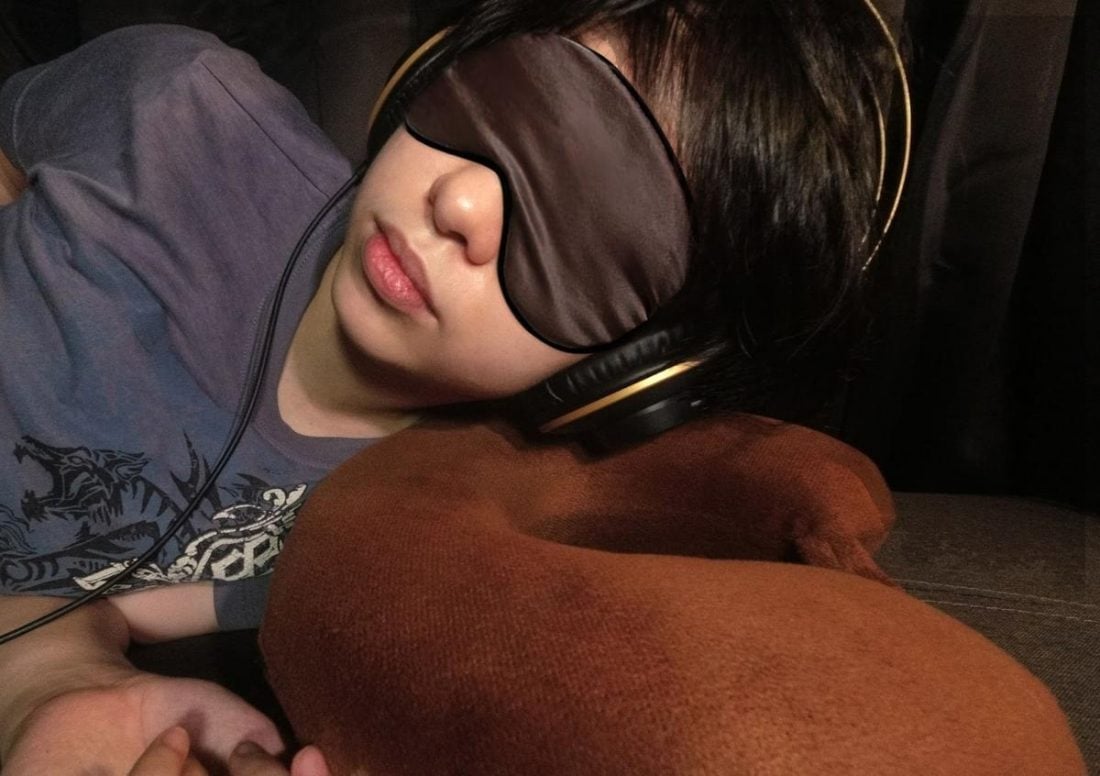
Another way to use a travel pillow to relieve pressure on your headphones is to use it as a pillow for sleeping on your side. Much like the pillow with a hole, travel pillows also have a crater in the middle where your headphones could easily slot in.
This is a great and innovative way to sleep on your side while wearing headphones.
Get headphones that make sleeping easier
Plenty of manufacturers have finally realized the demand for headphones designed for sleep and are responding.
Typically, these headphones have a low profile and don’t protrude from the ear so that when you turn to the side, you feel nothing pressing against your ear.
There are a few types of headphones in this category.
Headband headphones
These look like a regular sports headband that’s made of fabric and wraps around the head, but they have a pair of ultra-slim, padded speakers inserted inside. The fabric can be washed, but always remember to remove the speakers first.
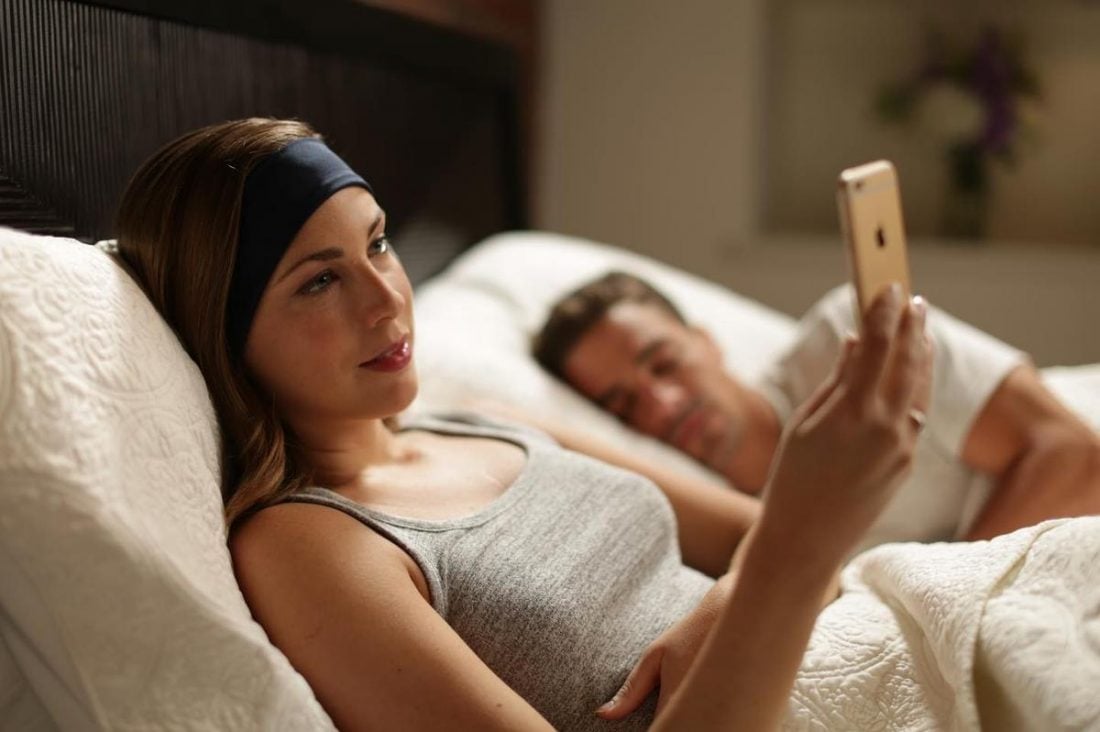
Popular brands include:
- SleepPhones – These are lightweight headband headphones that can be plugged into a standard 3.5-mm jack. A wireless Bluetooth version is also available so you can move around without restriction.
- CozyPhones – These have a contoured design that allows the headband to conform to the shape of your head. They also double as an eye mask for blocking out light. CozyPhones are available for adults and children.
- Jarvania – If you’re looking for sleep headphones that you can also use while exercising, check out Jarvania. They have a built-in mic so you can make calls hands-free during your workout.
Low-profile earphones
Low-profile earphones usually have soft silicone tips that follow the shape of your ears so that you barely feel a thing. These were designed especially for people who want to sleep with headphones on.
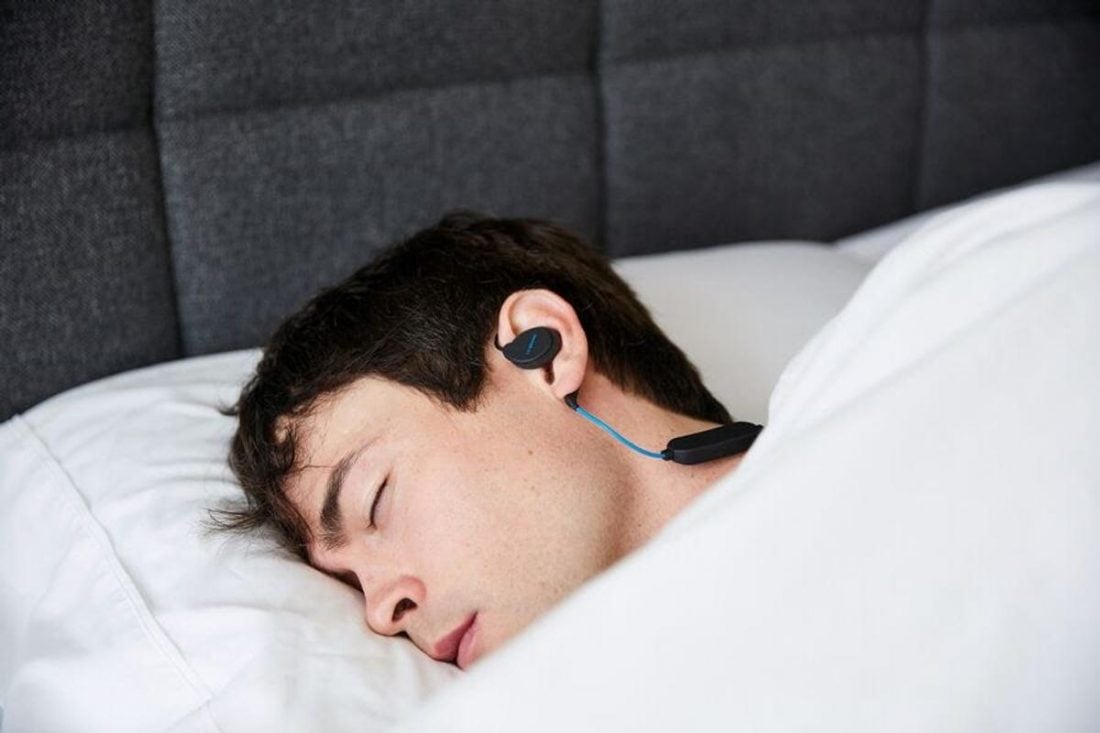
Popular brands include:
- Bedphones by Moonbow – These are on-ear headphones with ¼-inch-thick earcups that sit flat on your ears. The rubber-coated memory wire conforms to the shape of your outer ears so you can adjust the headphones for maximum comfort.
- QuietOn Sleep Earphones –These earphones come with active noise-canceling to drown out low-frequency sounds like snoring and city traffic. Ear tips also come in small and medium sizes to accommodate various ear sizes.
- Moondrop Kanas Pro – If you want to keep your earbuds in while sleeping, get this pair of earphones. The Kanas Pro by Moondrop has an over-the-ear memory cable that can be adjusted so that it fits snugly over your outer ears. It also comes with soft, light ear tips in various sizes so you can choose the right size of your ears.
True wireless headphones
Can you sleep with wireless headphones on? Yes, but it gets more comfortable if you’re using true wireless earbuds.
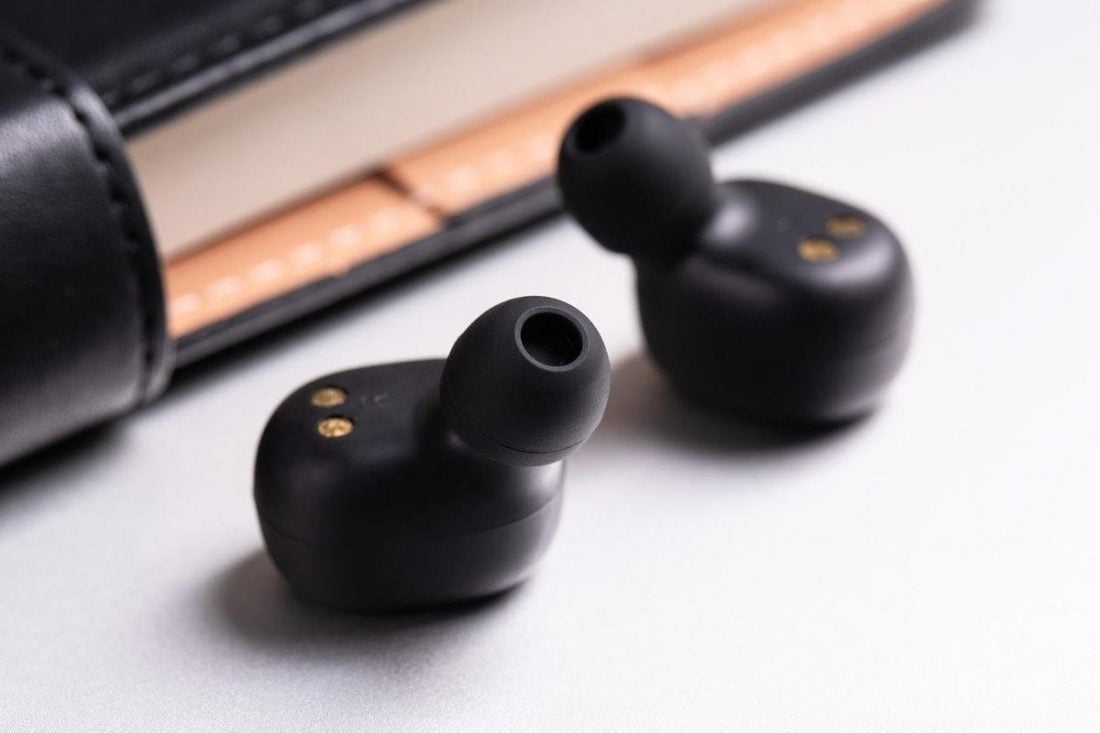
These fit snugly in the ear and don’t have cables that you could get tangled up in. Some models also have active noise-canceling so you can block out sounds that keep you from falling asleep.
Because these headphones are so small, they have small batteries cramped inside the tiny space inside the earbuds. This forces you to compromise on battery life.
Most decent pairs can get you up to three hours of nonstop listening max. Some of the more expensive ones can extend battery life up to five or six hours.
That shouldn’t be a problem if you only need to listen to music to fall asleep. But if you can’t stay asleep without music, truly wireless headphones may not be the best solution for you.
Sleep in a different position
This may seem obvious, but not a lot of people are willing to give this a try because they’re used to the way they’ve been sleeping most of their lives.
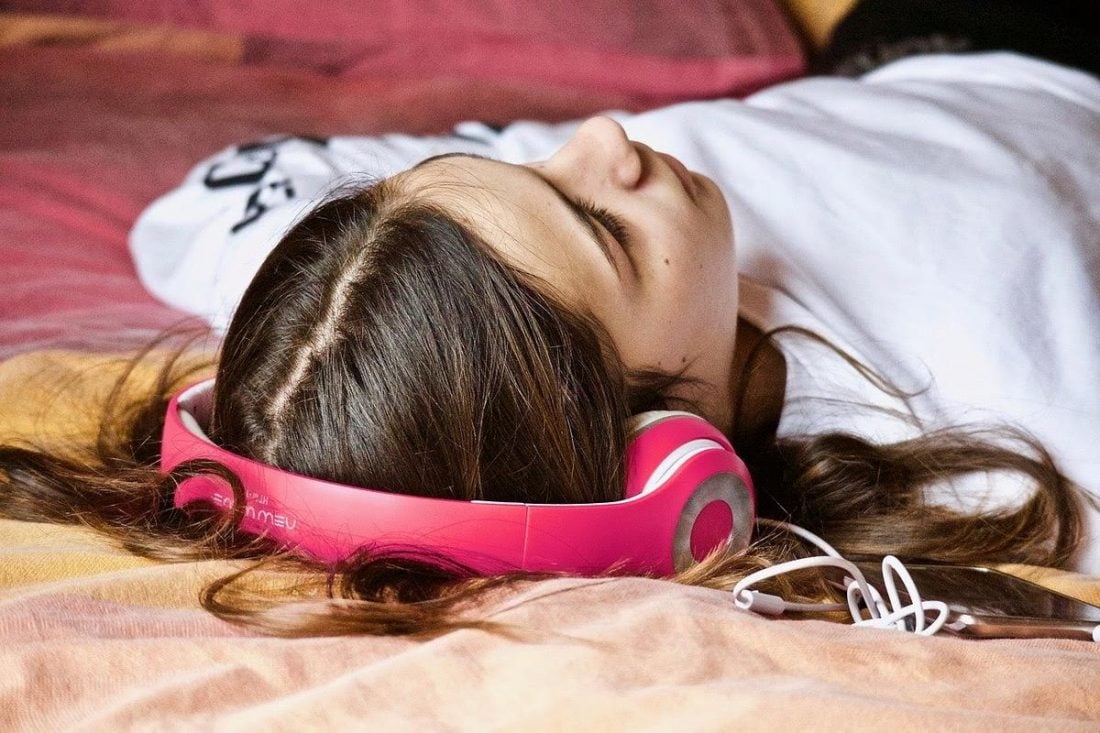
But if you insist on wearing headphones to sleep and don’t want to buy a new pair, you may want to try varying your sleep position.
Sleeping on your back is the easiest way to wear headphones in bed because you’re not putting pressure on your ears.
If you’re a side sleeper, consider getting a special pillow.
What Are the Advantages of Sleeping with Headphones On?
As mentioned before, going to sleep while listening to music has a lot of psychological benefits. In general, it helps you feel calm and relaxed so you can enjoy a good night’s sleep.
Shuts out loud, irritating, or excessive noise
Unfortunately, sometimes you live in a place that’s just downright noisy.
You might live in the city, where you’re constantly exposed to the sounds of traffic or even ongoing construction at night. You could have rowdy housemates or neighbors who like to party all night long or practice music with their band. Or, it could be that you do live in the peaceful suburbs, but your spouse snores loudly.
Getting a good pair of headphones can block out sounds like these that prevent you from going to sleep.
Lets you relax to your favorite music and media
Listening to relaxing sounds has been proven to help people go to sleep. Research shows people who listen to relaxing music 45 minutes before bedtime fall asleep faster, sleep longer, and wake up less during the night. Listening to podcasts, audiobooks, ASMR videos, and other media that you enjoy can also help.
In 2011, the English band Marconi Union in cooperation with the British Academy of Sound Therapy wrote a song designed to help listeners fall asleep. It works by starting at 60 bpm and ends at 50 bpm. The song, titled “Weightless”, has been dubbed the most relaxing song ever.
Boosts your psychological, mental, and emotional well-being
There’s plenty of science proving music therapy as a reliable way to cope with mental health difficulties.
For instance, this study shows listening to music positively affects the autonomic nervous system, which regulates bodily functions, so you can recover from stressful events more easily.
It’s been also shown to improve the sleep quality of depression patients with insomnia and reduce the symptoms of PTSD.
Music also stimulates the production of dopamine, a brain chemical associated with the pleasurable feelings of receiving a reward. In other words, listening to music can feel like getting a reward.
What Are the Disadvantages of Sleeping with Headphones On?
Keep in mind that there are dangers to sleeping with headphones. If you don’t wear them properly or if you use them too much, headphones can cause the following problems, which range from mild to severe:
Wax buildup
Earphones can cause hard wax buildup because the seal doesn’t allow air to circulate properly inside the ears. If left unaddressed, hardened wax can cause temporary hearing loss and even permanent damage over time.
Otitis externa
Also known as swimmer’s ear, otitis externa is a painful infection that happens when the ear is exposed to too much moisture.
Prolonged wearing of earphones can cause the skin of the ear canal to wear out. When this happens, the ear loses its ability to keep water and other fluids out. The excess moisture also prevents the ear from producing ear wax, which provides natural protection against microbes that might breed inside the ear canal.
Symptoms include pain, redness, swelling, and itching in the ear. You may also see a discharge of pus or fluid. Some patients also experience diminished hearing that goes away once the infection is treated.
If left untreated, otitis externa can cause serious problems. Always visit a medical professional if you suspect you have otitis externa.
Necrosis, or the death of tissue cells
Necrosis happens when tissue cells die permanently.
It’s not likely to happen, but there’s still a chance of that. Wearing headphones too often can cause infection or trauma that can lead to necrosis.
This can result in partial or complete hearing loss. In the worst cases, it can also lead to having the ear amputated or having parts of it removed.
Strangulation by headphone cords
There’s a slim chance of getting strangled by headphone wires while you sleep, but it can still happen. If you’re a rough sleeper who likes to sleep with wired headphones, the greater the chances of this occurring.
If the strangulation is serious, you risk cutting off your oxygen supply and could pass out in your sleep. To eliminate this risk altogether, it’s best to use wireless headphones.
Hearing loss from listening to music
If you’re sleeping with headphones on, you could accidentally turn the volume up. Listening to loud music for too long can cause permanent damage to your ears.
Most headphones have a maximum volume of 85 to 110 decibels. The US Occupational Safety and Health Administration says listening to sound that’s 85 decibels and up over an eight-hour period is too loud.
It’s equivalent to the loudness of lawnmowers and leaf blowers and can cause hearing loss if the listener doesn’t have hearing protection.
For headphones, it’s best to keep the volume at 60%. Listening to anything louder than that can lead to hearing problems in the future.
Is It Bad to Sleep With Noise-Canceling Headphones?
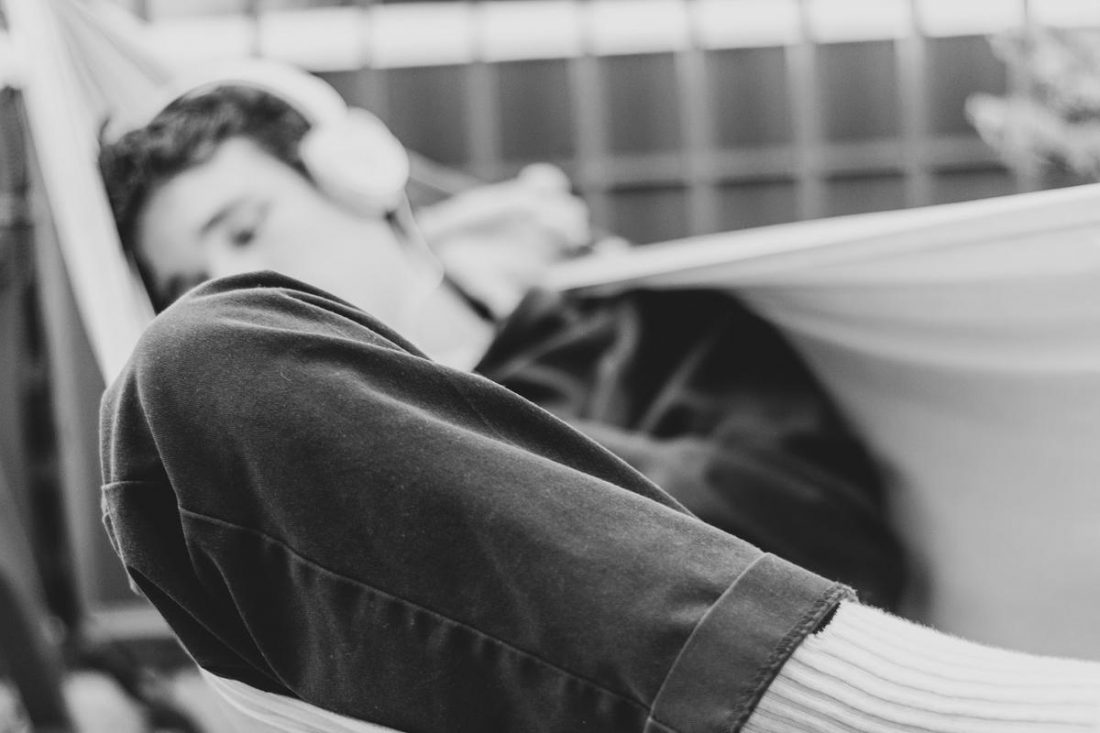
There are two types of noise cancellation: passive and active. Regular headphones usually come with passive noise cancellation. However, Active noise-canceling (ANC) headphones stand out better on blocking ambient noise.
Noise-canceling headphones may be preferable to some because they block noise better. But there are some safety concerns linked to the use of noise-canceling headphones, especially for sleeping. These include perceived tinnitus and pressure on the ears after prolonged headphone use. However, these effects of ANC headphones are mostly isolated cases. They only happen to very few users.
Other sleep-specific concerns on using ANC headphones also include:
Not hearing important alarms, sirens, or calls for help
If you wear headphones to sleep, you might miss important sounds you need to wake up to. Some of these can be smoke or fire alarms, cries for help from a family member, or even a burglar.
Hard to find a comfortable position
Most noise-canceling headphones have bulky over-ear configurations. That’s because you need a tight seal over the ears to ensure the noise cancellation works well. The downside is, it doesn’t exactly make the headphones great for sleeping. Side sleepers may end up with a stiff neck, while rollers might lose their headphones in their sleep.
Some brands try to address these problems by designing more sleep-friendly headphones. But more often than not, they aren’t as comfortable as headbands or sleep mask headphones.
High cost and high risk
Noise-canceling headphones are pricier because of the added noise cancellation technology. So opting for a pair of these may put a significant dent in your budget.
Also, these types of headphones aren’t built for use during sleep. Most have touch-sensitive control panels located on the outer part of the ear cup. So the slightest movements could trigger volume changes that could damage hearing.
Hot ears
Noise-canceling headphones use high-density foam or silicone to seal the ears. As mentioned, this ensures the noise cancellation works at its best. Yet this seal can also make the ears feel hot and stuffy, which can take you away from a good night’s sleep.
Most manufacturers make it a point to design breathable ear cups. Still, most don’t compare to the breathability of headphones designed for sleep.
Aside from having breathable materials, headphones made for sleep also have washable components. This helps keep them free from dirt or sweat build-up that may affect ear health.
Moreover, most noise-canceling headphones don’t have washable components. So, sweat build-up during sleep can cause faster ear padding degeneration. This makes the ear pads more brittle and uncomfortable to wear as time goes on. You may be forced to replace your headphones’ ear padding, after a few months’ use.
Can Noise-Canceling Headphones Block Snoring?
The short answer is: yes.
ANC headphones are much better at reducing background noises like snoring.
Noise-canceling headphones are finely-tuned to detect low-frequency sounds. Such sounds can include airplane engines, air conditioners, and yes, even snoring.
Some ANC headphones can even cancel sounds like snoring without playing any music. Simple turn on the noise-canceling feature and you’re good-to-go! This means you can easily help your ears take a well-deserved rest every night.
These reasons make noise-canceling headphones an appealing choice for sleep, despite the safety concerns mentioned above.
What are the alternatives to sleeping with headphones on?
If sleeping with headphones isn’t right for you, but you still want to listen to music at bedtime, you still have plenty of options.
Play music on a stereo or portable speaker
Having portable speakers in your bedroom is beneficial if you listen to music while sleeping. Some speakers come with a remote control, allowing you to play, pause, skip music, or change the volume without getting up from your bed.
You can also connect the speakers to your smartphone so you can listen to your favorite saved media or play music through a music streaming service like Spotify.
Listen to music from your phone speakers
If you’d rather not spend money on new speakers, you already have a speaker you can use.
Smartphone speakers provide plenty of power to play soft music throughout the night but not enough to blare out loud music that could damage your ears.
Smartphones are also small enough to be placed close to your head. Just keep in mind not to put yours too close or to turn the volume way too high.
Buy a white noise machine
White noise is the sound that’s made when frequencies of all ranges come together to create a constant sound similar to that of television static or a fan blowing air. Some people say it’s more like the sound of a waterfall or the wind blowing through trees.
White noise masks background sounds that can keep you from going to sleep. It also gives your busy brain a distraction to play with so that it’s not constantly on alert looking out for the slightest trace of sound.
Research also shows listening to white noise at night can also increase sleep time. Hence, you might want to invest in a white noise machine that helps to emulate the correct ambiance that you need for a night of good sleep.
Conclusion
Sound and music are vital parts of our lives. Our ancestors have been making and listening to music since they began making the first instruments from bird bone. Forty thousand years after, we keep discovering new ways music can make our lives better.
Using a good pair of headphones to listen to your favorite music doesn’t just help you sleep better for one night. It helps you reduce stress in the long run so you can become a healthier, happier person.
Interested with buying your first headphones to help you with sleeping but don’t know where to start? Feel free to check out our comprehensive guide on how to pick the best sleep headphones along with the best models in the market today.
What do you think of the options we’ve provided? Have you found a way to sleep comfortably with headphones on? Do you have other tips, tricks, and product recommendations to make sleeping with headphones better for our readers? Let us know in the comments below.
